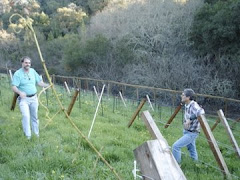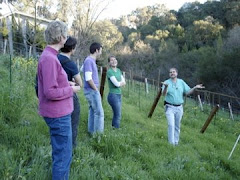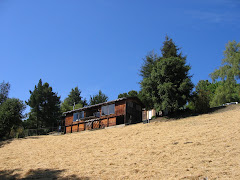Hope you all had an enjoyable Fourth of July! We are popping out with all kinds of leafy growth up here! Our grapevines are loving this moderate, coastal, cool, summer weather pattern. Great for long term summer growth!
That is generally the idea behind our vintage producing California wine regions. Along our California coasts, on the eastern side of the Coastal Mountains, are many areas that get evening & morning cooling from the coastal climate. Imagine Carmel or the Mendicino coastline with its fog, moderate ocean breezes, etc. A little ways inland we find areas like Napa, Sonoma, inland Mendocino, the Livermore Valley, Santa Cruz Mountains, Solvang (remember the movie "Sideways"), inland Santa Barbara, etc. But our California Central Valley just does not get that coastal cooling, because it is too far inland and it is generally hot there all summer long. Therefore, the grapes in the Central Valley tend to ripen quickly without slowly developing further complex flavors. Think of 100 degree Fresno heat, Seedless Thompson's, the Raisin Capital of the World!
However, I just had a Central Valley 2007 "Old Vines" Zinfandel (Zymmestry, Lodi, CA), courtesy of my good friend Tim Chou, that was just fantastic! (Not to mention Tim's Fantastic North Carolina BBQ & Sue's amazing cole slaw & potato salad!) The 2007 California Zinfandel harvest is being heralded as the best ever over the two recent 2006 & 2005 best ever award winning years, making for a perfect "trifecta"! So, that begs the question, how are they growing such complex, flavorful wine grapes in Lodi, CA, smack dab in the middle of the Central Valley, not to mention other areas like the Sierra Foothills and even Fresno!
Tim's zinfandel was grown on "Old Vines", which has two different meanings. One is that the grapevines are old, 25, 50, 100 years old or older. Mind you, there is no regulation of how old "Old" is in the wine industry! At about 50 years old, grapevines output diminish, but the quality of these grapes tend to be very high. Some large production vineyards would consider replanting these vines at this point to maintain the high volume output of a younger vine. Interestingly though, there are many small vineyards dotting California's Central Valley, that were planted by California's European-Americans' need for wine in response to our 1920 - 1933 U.S. Constitutional Prohibition of Alcohol. Originally for personal wine consumption (which was legal), many of these vineyards have survived, have been re-discovered and are now producing very high quality wines today.
Another aspect of these personal Prohibition vineyards was that they often used un-grafted rootstock (the original European grapevine rootstock), another definition of the term "Old Vines". These grapevines have survived Phylloxera, because our little soil louse doesn't like the poor sandy, rocky soils that these Prohibition vineyards were typically planted in. There are some in the industry that say these un-grafted European rootstock produce better wines than the American grafted rootstock, citing wines of un-grafted rootstock still producing in the American Northwest (Washington, Oregon), from Chilé and from the California Central Valley! (See Young Oak Vineyards: Volume 4 - Rootstock, for further information regarding Phylloxera.)
So, although these Central Valley grapes are ripening faster due the heat, their "Old Vines" may be imparting high quality flavors to these grapes either because they are "Old" in years and/or because the grapevines have original European rootstock! Check out some of these California "Old Vines" for yourself! They are delicious! And thanks again, Tim & Sue!
I wanted to take some pictures of my vines for this blog post, but I am still on crutches after my hip replacement surgery and I cannot get down in the vineyard just yet. Hope you had a wonderful Fourth of July weekend! Best wishes to all your families and friends for a great summer!
Regards from up in my bed, flat on my back, John




























































































































